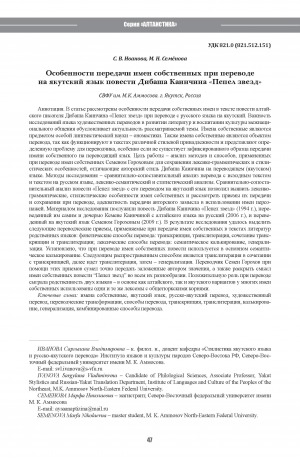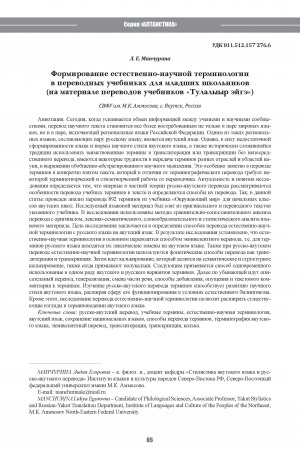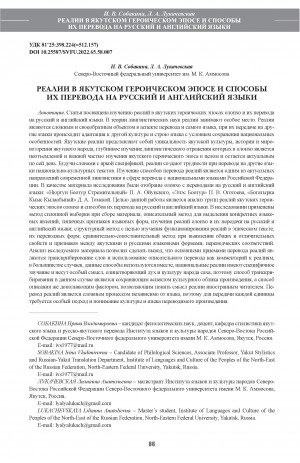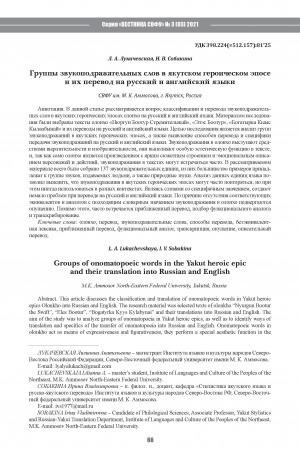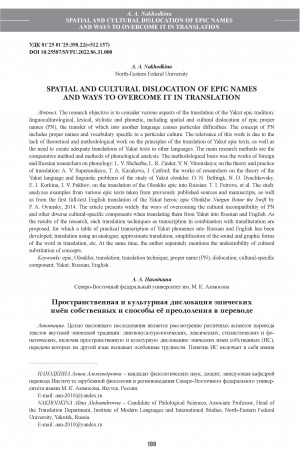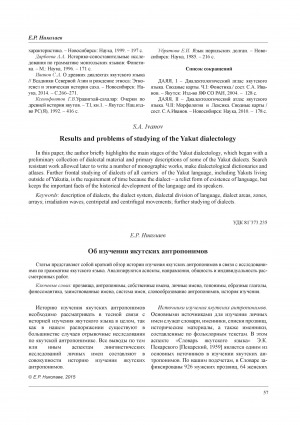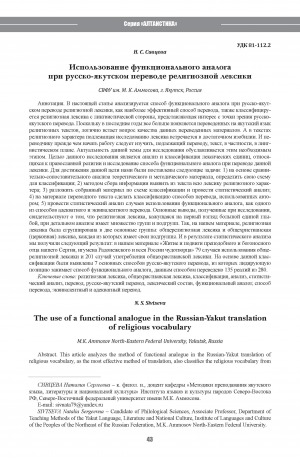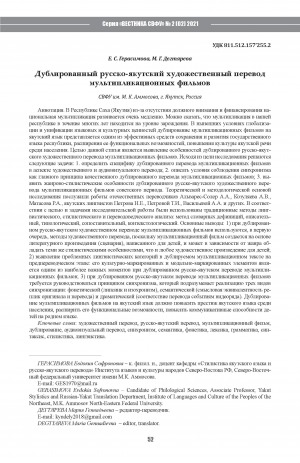
Имя собственное в художественном тексте (на примере романа Н. Е. Мординова "Весенняя пора") = Proper name in a literary text: the case of the novel by Nikolai Mordinov “Springtime”
Статья в журнале
Русский
821.512.157-31Мординов.03=161.1
10.25587/2782-6627-2024-4-46-53
имя собственное; антропонимы; топонимы; якутско-русский перевод; сопоставительный анализ; способы перевода; транскрипция; транслитерация; художественная литература; proper name; anthroponyms; toponyms; Yakut-Russian translation; comparative analysis; translation methods; transcription; transliteration; fiction
This article attempts to identify ways of translating proper names from Yakut into Russian, in particular anthroponyms, toponyms, based on the translation of the novel by Nikolai Mordinov - Amma Achchygyya “Saski kem” (“Springtime”). The relevance of the research lies in studying the issue of the functioning of a proper name in fiction and the problem of transferring Yakut proper names into Russian. The problem of translating anthroponyms and toponyms with ethnic and cultural specifics is one of the controversial issues in translation studies. The translator faces a difficult task: the translation of a specific word that has no analogue in the target language, taking into account the phonetic, lexical and grammatical features in the literary text. The purpose of the work is to conduct a comparative analysis of real and fictional proper names in the original language and in the target language (Russian) in fiction. Descriptive, comparative, contextual methods of analysis were used during the work. As a result of the study, we propose a classification of the main methods of translating anthroponyms, such as transliteration, transcription, creation of a new word, descriptive and literal translations; dividing toponyms into real and fictional proper names. Having analyzed the translation of the proper names in the Mordinov’s novel “Springtime,” we came to the conclusion that the most common was the translation of the anthroponym using transcription, this method translated 43 of the proper names out of 72. Of the 27 toponyms, 6 are real geographic names. The author uses toponyms in the work to give specificity to the actions of characters in a real geographical location to show the scale of the civil war for the establishment of Soviet power in the central and northern regions of Yakutia.
Старостина, А. С.
Имя собственное в художественном тексте (на примере романа Н. Е. Мординова "Весенняя пора") / А. С. Старостина ; Северо-Восточный федеральный университет им. М. К. Аммосова // Вестник Северо-Восточного федерального университета им. М. К. Аммосова. Серия "Алтаистика". - 2024. - N 4 (15). - С. 46-53. - DOI: 10.25587/2782-6627-2024-4-46-53
DOI: 10.25587/2782-6627-2024-4-46-53
- Языкознание. Филология. Художественная литература > Литература. Литературоведение > Теория литературы. Изучение литературы. Литературная техника > Художественная литература на отдельных языках > Якутская (саха) литература,
- НАУКА ЯКУТИИ > ЯЗЫКОЗНАНИЕ. ФИЛОЛОГИЯ. ЛИТЕРАТУРОВЕДЕНИЕ. ХУДОЖЕСТВЕННАЯ ЛИТЕРАТУРА > Литература. Литературоведение.
Войдите в систему, чтобы открыть документ
